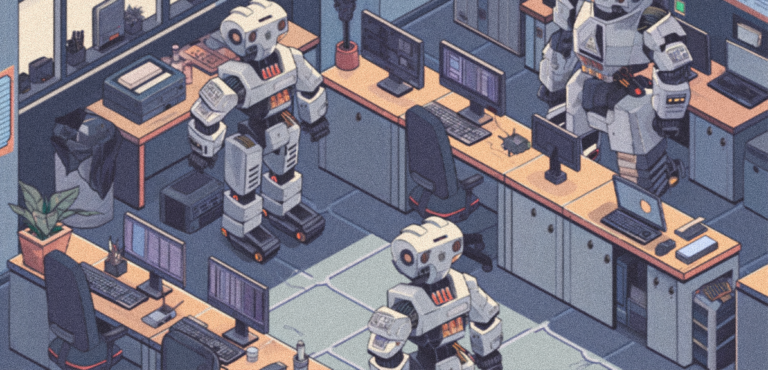Article

How the AI Revolution is redefining intelligent work
The whirring of robotic arms in car factories and the soft hum of data centres processing information are testaments to the rise of AI revolution in the workplace. While headlines might scream “Robots Taking Over Our Jobs!”, a more nuanced picture emerges when you dive into enterprise AI.
In almost all cases, AI technology in industries are supplementing human work – not replacing or eliminating jobs. But let’s talk about the specifics of how AI is reshaping the workforce, highlighting success stories of human-AI collaboration, and dipping a toe into predicting the future of work.
Breaking down the human + AI revolution by industry
AI on the assembly line: partners, not replacements
In car factories like those run by BMW, robots with names like “KUKA” and “ABB” are no longer confined to monotonous tasks. Equipped with sophisticated AI and advanced sensors, these robots collaborate with human workers on complex assembly line tasks. Robots handle the heavy lifting and precise welding, while human workers oversee the process, ensure quality control, and troubleshoot any issues. This human-AI partnership allows for increased efficiency and production speed, while also freeing up human workers for more creative and strategic tasks like production line design and problem-solving.
AI’s expanding reach in finance
The impact of AI extends far beyond manufacturing. In the world of finance, AI-powered tools like Kensho and AlphaSense are used by human analysts at firms like Goldman Sachs to sift through vast amounts of financial data. These tools identify trends, predict market movements, and suggest potential investment opportunities, allowing human analysts to focus on strategic decision-making and client relationships.
AI empowering medical professionals
The healthcare industry is witnessing a surge in AI-powered tools designed to assist medical professionals. IBM’s Watson Health allows doctors to analyse patient data with greater speed and accuracy, identifying potential health risks and suggesting evidence-based treatment options. This frees up valuable time for doctors to spend with patients, providing personalised care and building trust.
AI on the frontlines of the customer service revolution
The world of customer service is experiencing a transformation with chatbots like those powered by Microsoft’s Azure Bot Service handling first-line customer inquiries. These AI-powered chatbots can answer frequently asked questions, resolve simple issues, and even schedule appointments. This frees up human customer service agents to focus on complex issues and build stronger customer relationships. However, the human touch remains irreplaceable – empathy, emotional intelligence, and the ability to navigate complex situations are crucial for providing exceptional customer service.
The future of work: a human-AI collaboration landscape
While AI automates some routine tasks, it also creates entirely new roles. Here’s a glimpse into the future workforce landscape:
- AI developers: With the ever-growing presence of AI, the demand for skilled individuals who can design, develop, and maintain these intelligent systems is surging.
- Data scientists: While data becomes the fuel driving AI, the ability to collect, analyse, and interpret vast amounts of data becomes a valuable skill. Data scientists will be crucial for extracting meaningful insights from data to inform decision-making across industries.
- Human-AI collaboration specialists: As humans and AI work ever closer, specialists who can bridge the gap and ensure seamless collaboration will be in high demand. These specialists will need to understand both human and AI capabilities to optimise workflows and communication.
Human advantage: where we thrive
Building a successful human-AI collaborative future hinges on overcoming several key challenges. Ensuring fairness and ethical principles in AI development is crucial, addressing potential biases in algorithms and guaranteeing transparency in how AI decisions are made. Fostering trust between humans and AI systems requires open communication, clear explanations of AI functionality, and maintaining human oversight over AI decision-making processes. By tackling these challenges head-on, we can pave the way for a future where humans and AI work together seamlessly to achieve remarkable progress.
Here’s how this collaboration could play out:
- Companies like Siemens are already utilising AI-powered tools for predictive maintenance in factories. These tools analyse sensor data from machinery to identify potential issues before they occur, preventing costly downtime and improving operational efficiency. However, human technicians remain crucial for troubleshooting complex problems and ensuring overall system health.
- In the healthcare sector, IBM’s Watson Health is assisting medical professionals by analysing patient data to identify potential health risks and suggest personalised treatment options. This frees up valuable time for doctors to spend one-on-one with patients, providing a more holistic and compassionate care experience.
- The world of education is witnessing a surge in AI-powered personalised learning platforms. These platforms tailor educational content to individual student needs, helping them learn at their own pace. However, dedicated human teachers remain essential for providing guidance, motivation, and emotional support that AI cannot replicate.
These are just a few examples of how human-AI collaboration is transforming various industries. By working together, humans and AI can achieve remarkable progress, solve complex challenges, and create a more sustainable and prosperous future.
Distilled
The rise of AI isn’t a discordant note in the symphony of progress. It’s an opportunity to compose a new and powerful movement, a human-AI collaboration that unlocks a future brimming with innovation and progress. Let’s embrace the potential of working together and write a future where humans and AI create a masterpiece.